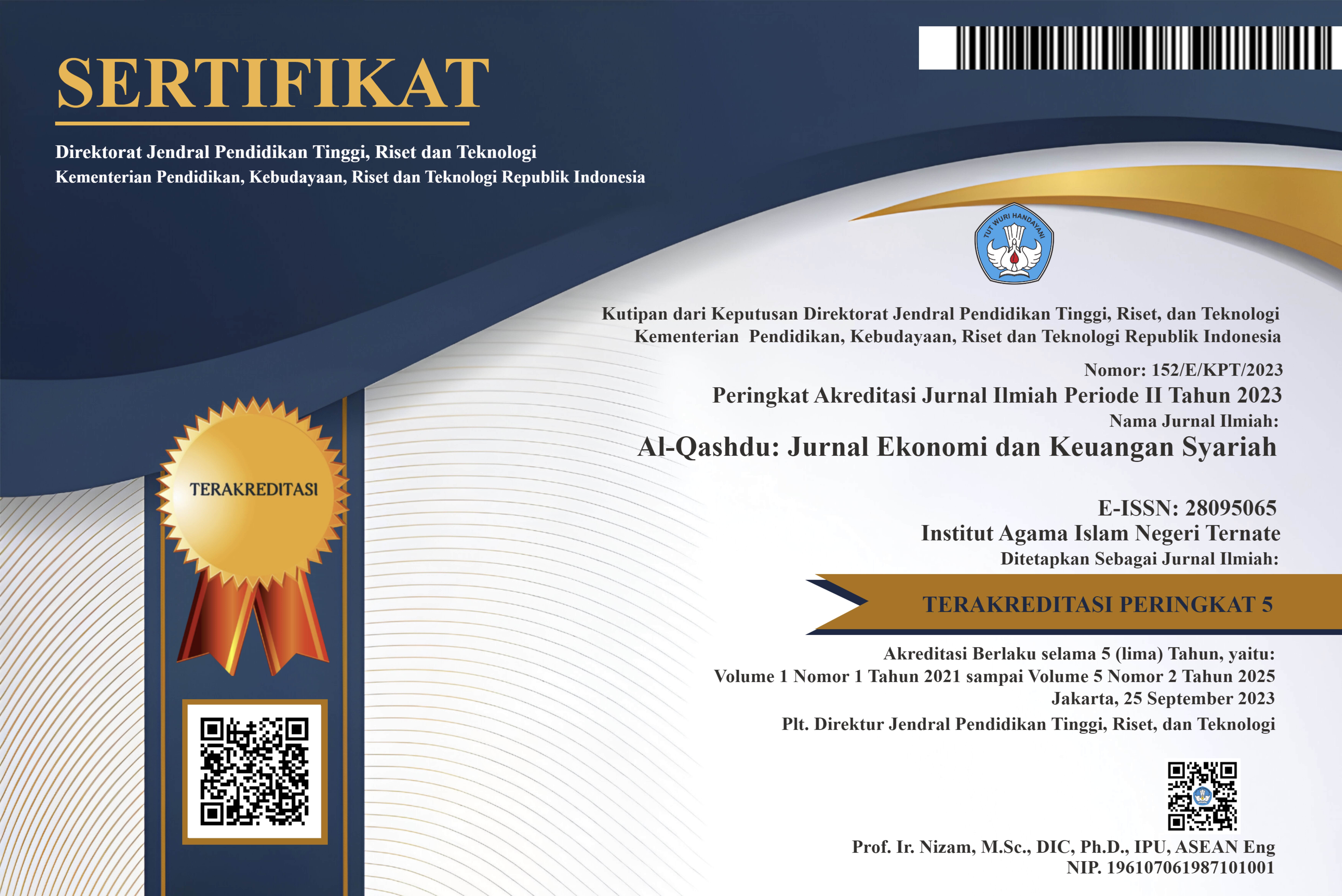ANALISIS EKSPOSUR RISIKO REKSADANA SYARIAH DAN REKSADANA KONVENSIONAL DI INDONESIA DENGAN PENDEKATAN CAPM, MARKET TIMING ABILITY DAN DOWNSIDE RISK
Abstract
Full Text:
PDFReferences
Abdullah, F., Hassan, T., Mohamad, S., (2007). Investigation of performance of Malaysian Islamic unit trust funds: comparison with conventional unit trust funds. Manag. Financ. 33 (2), 142–153. http://dx.doi.org/10.1108/03074350710715854
ACMA, M. Q. (2014). Comparative Study on Performance Evaluation of Mutual Fund Schemes in Bangladesh: An Analysis of Monthly Returns. Journal of Business Studies Quarterly Volume 5, Number 4, 190.
Aziz, M., Nadir, M., & Purnamasari, I. (2017). Portofolio reksadana & kinerja keuangan perbankan. Mulawarman University Press.
Bahsoun, R., & Hakimi, A. (2020). Downside risk: is downside risk being priced in the US stock market?.
Begum, N. N,. dan Rahman, S. (2016). An Analytical Study on Investors’ Preference towards Mutual Fund Investment: A Study in Dhaka City, Bangladesh. International Journal of Economics and Finance Vol. 8, No. 10, 184-191.
BI. Apa itu JIBOR (Jakarta Interbank Offered Rate).
Cici, G., dan Palacios, L. F. (2015). On the use of options by mutual funds: Do they know what they are doing? Journal of Banking & Finance 50, 157–168.
Dicembrino, C., dan Scandizzo, P. L. ( 2012). Can Portfolio Diversification increase Systemic Risk? Evidence from the U.S and European Mutual Funds Market. CEIS Tor Vergata RESEARCH PAPER SERIES Vol. 10, Issue 8, No. 240.
Erdős, P., & Ormos, M. (2009). Return calculation methodology: Evidence from the Hungarian mutual fund industry. Acta Oeconomica, 59(4), 391-409.
Estrada, J. (2006). Downside Risk in Practice. Journal of Applied Corporate Finance Vol. 18 Number 1, 117-125.
Fama, E.F. and French, K.R. (1993). Common risk factors in the returns on stocks and bonds. Journal of Financial Economics, Vol. 33 No. 1, 3-56.
Guo, J., Ma, C., & Zhou, Z. (2012). Performance evaluation of investment funds with DEA and higher moments characteristics: financial engineering perspective. Systems Engineering Procedia, 3, 209-216.
Hamzah, A., dan Yohanes, A. ( 2014). Analisis Perbandingan Kinerja Reksa Dana Syariah dengan Reksa Dana Konvensional Jenis Saham pada Periode 2008 – 2012. MIX: Jurnal Ilmiah Manajemen, Volume IV, No. 3, 396 - 409.
Hayat, R., dan Kraeussl, R. (2011). Risk and return characteristics of Islamic equity funds. Emerging Markets Review, Vol. 12 No. 2, 189-203.
Hoepner, A. G,. Rammal, H. G, dan Rezec, M. (2011). Islamic mutual funds’ financial performance and international investment style: evidence from 20 countries. The European Journal of Finance Vol. 17, Nos. 9–10, 829–850.
Khawaja, F. N. (2020). Are Islamic mutual funds exposed to lower risk compared to their conventional counterparts"? Empirical evidence from Pakistan. ISRA International Journal of slamic Finance Vol. 12 No. 1, 69-87.
Mardadika, Y. P., Haris, Z. A., dan Bakhrudin, B. (2021). Analisis Perbandingan Kinerja Reksadana Konvensional dengan Reksadana Syariah Berdasarkan Risk and Return. Seminar Nasional Gabungan Bidang Sosial - Polinema. Vol. 3, No, 1, 113-123.
Matallin, J. C. dan Nieto, L. (2002). Mutual funds as an alternative to direct stock investment: A cointegration approach. Applied Financial Economics, 12(10), 743-750.
Mulyawan, S. (2016). Kinerja reksa dana syariah dan beberapa faktor yang memengaruhinya: studi di pasar modal Indonesia 2010-2013. Ijtihad, Jurnal Wacana Hukum Islam dan Kemanusiaan Vol. 16, No. 2, 218. doi:10.18326/ijtihad.v16i2.217-236
Musdalifah Azis, M. N. (2017). Portofolio Reksadana dan Kinerja Keuangan (T. Fitriastuti, Ed.) Samarinda: Mulawarman Univercity Press.
Putri, S. D. (2021). Analisis Perbandingan Riskdan Returnreksadana Syariah Jenis Saham Berdasarkan Metode Sharpe, Treynor, dan Jensen (Studi Kasus Perusahaan Terbuka Yang Tercatat Di Bursa EfekIndonesia (BEI) Tahun 2016-2019). Jurnal AKRAB JUARA, Vol. 6 No. 3, 72-87.
Raj, Mahendra; Forsyth, Michael; Tomini, Ortenca (2003). Fund Performance in a Downside Context. The Journal of Investing, 12(2), 50–63. doi:10.3905/joi.2003.319544
Rapini, T., Farida, U., & Putro, R. L. (2021). Eksistensi Kinerja Reksadana Syariah Pada Era New Normal. Jurnal Tabarru': Islamic Banking and Finance, 4(2), 356-368.
Rodriguez, J. (2015), Are micro-cap mutual funds indeed riskier?, Review of Accounting and Finance, Vol. 14 No. 4, 352-362. https://doi.org/10.1108/RAF-03-2015-0045
Tchamyou, V. S., Asongu, S. A., & Nwachukwu, J. C. (2018). Effects of asymmetric information on market timing in the mutual fund industry. International Journal of Managerial Finance.
Treynor, J.dan Mazuy K. (1966). Can mutual funds outguess the market. Harvard Business Review, European Journal of Operational Research, Vol. 233 No. 3, 613-624.
DOI: http://dx.doi.org/10.46339/al-qashdu.v3i1.932
Refbacks
- There are currently no refbacks.

This work is licensed under a Creative Commons Attribution-NonCommercial-ShareAlike 4.0 International License.

This work is licensed under a Creative Commons Attribution-NonCommercial-ShareAlike 4.0 International License.
Al-Qashdu: Jurnal Ekonomi dan Keuangan Syariah
Published by Faculty of Islamic Economics and Business, Institut Agama Islam Negeri (IAIN) Ternate
Jl. Lumba-lumba, Ternate City, North Maluku, Indonesia, 97727
Website: https://www.iain-ternate.ac.id/
Phone: +6281241674617
Email: [email protected]

